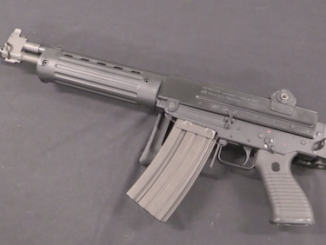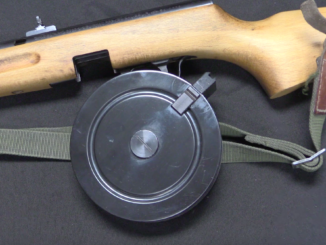The Italian army actually adopted a semiautomatic rifle in 1939: this Armaguerra Model 1939. It was intended to supplant the M38 Carcano bolt actions, but ultimately never managed to get into mass production.
The rifle was adopted initially in the new 7.35mm cartridge, and then quickly cancelled, as the new cartridge was dropped for logistical and financial reasons. This was not an immediate problem for the company, as they did not have a rifle factory in operation anyway – they began building one in Cremona only after receiving an initial order for 10,000 of the rifles. In the wake of the caliber change, the Armaguerra rifle was quickly redesigned for the 6.5x52mm cartridge. Ultimately only about 100 were made, and the factory was retooled to produce Carcano bolt action rifles instead.
Mechanically, the Armaguerra 1939 is a short recoil action with a pivoting locking block similar in principle to the Walther P38 pistol. It is a sleek weapon, using the front sling swivel as charging handle and thus avoiding any protrusions out from the sides of the action. It feeds from standard Carcano 6-round en bloc clips.




Oh boy, talking “user friendly”…. well in case you lost one finger to action be consoled, you have still nine left. If I use my own term to describe it, I’d say it is ‘over-inventive’.
Other than that, this rifle is ‘una arma molto bellissima’. Almost tragically pretty.
A little afterthought: visible movement at front end is really short; I’d guess 5mm. At the same time, wear mark at the moveable ‘barrel extension’ is said to be cca 10mm. Why is that? I do not suspect some kind of motion multiplier/ accelerator in this design.
If that motion before unlock was just 5mm, I am almost sure (given length of barrel) is not enough to be safe. But of course, I see just video which may not be enough to understand it.
I think it’s just sticky, and doesn’t want to move the full travel.
From the sound you hear opening the action, the thing needs a good lubrication.
This seem to be the case with many showcased guns – not in running order due to neglected maintenance. But then, if they hanged in someone’s depository, no wonder.
It should be a more heavier “Buffer” spring within remaining distance.
That is probably the case. At any such system heavy barrel return spring is a requisite.
That dual-function forward sling swivel is a questionable “advantage” at best.
The Steyr MPi 69 9mm SMG had a similar setup. On the successor MP 81 version, it was replaced by a conventional cocking handle and a fixed front sling swivel.
The problem is that anything that catches the sling could rack the bolt and chamber a round whether you want it to or not. In the MPi 69’s case, it could also fire the weapon, since it was an open-bolt API type.
Dual-function “features” on small arms are generally more trouble than they’re worth.
cheers
eon
I don’t really like opening of the action in this rifle, but there is a safety lock anyway to prevent the more obvious incidents.
Obviously there is the remote possibility that that “anything” that catches the sling works the lock as well, but at that point, is more probable that something catches a classic-shaped bolt handle and cycles it.
Using an improvised rest could also be a problem. At least it is not a real heavy recoiling cartridge.
“Dual-function “features” on small arms are generally more trouble than they’re worth.”
For example early Browning automatic pistols have sights safety, see photo:
http://www.coltautos.com/1900ci_318.htm
which was later abandoned.
Anyway whatever dual-function is good or bad depends on what it is. For example OWEN sub-machine gun has one lever serving as safety/mode-of-fire selector, so far I know it was received well, so it must be sane solution.
On the Browning Hi-Power the slide stop has a triple function (or quadruple), and it’s one of its most intelligent features. Usually double function features are a good thing, if they allow to reduce the number of pieces.
“Oh crap, the sling’s stuck on a log!” [gets shot]
Is this the danger you were talking about?
I don’t really like opening of the action in this rifle, but there is a safety lock anyway to prevent the more obvious incidents.
Obviously there is the possibility that that “anything” that catches the sling works the lock as well, but at that point, is more probable that something catches a classic-shaped bolt handle and cycles it as well.
Only the Soviets and US awoke in time. Of course both nations managed to avoid early entry into the war.
“Only the Soviets and US awoke in time. Of course both nations managed to avoid early entry into the war.”
Anyway Soviet Union don’t manage to produce enough self-loading rifles to replace all Mosin rifles. In France MAS 40 rifle was developed, if France wouldn’t fall so rapidly it is possible that it would enter service, anyway this design was later developed in MAS-49.
is: “(…)enter service(…)”
should be: “(…)enter more widely service(…)”
For those interested in the internal mechanism, I believe that this is the patent:
https://www.google.com/patents/US2350821
Enjoy!
And here’s the patent for the trigger mechanism:
https://www.google.com/patents/US2356615
Thanks for the patents Brian. As revealed by the drawings and text, there is only one powerfull torsion spring for the barrel returning to the foremost position and, no additional buffer spring at all. The mechanical resistance of locking parts and their engagements, seem, create the second stage, more powerfull barrel going backward sequence. Stiker spring seems, also acts as the bolt return spring to the distance for the sear catch and remaining forward travel of the bolt to its foremost position, seems obtained through the gained momentum of bolt mass. Not a dependable construction for all field and battle conditions, especially when shooting upwards. Over all; The design seems rather Mickey Mouse.
You’ve got it Brian; thank you!
I printed myself locking mechanism diagram to see what is going on. The guy was no doubt clever, however overall approach resembles designs of older vintage.
The locking piece (No.4) is actuated by spur (No.14) which in turn is motivated by linkage (No.26 and 28). Looks bit too flimsy, but again, I need to see physical parts to make up my view.
Torsional spring (No.20) provides return force for barrel. It does not look very formidable, but is compact and well arranged. It looks that striker and bolt are forced forward by same spring located in stock. Is it then that this rifle is fired from open breech? Look to me that way.
I have to put in question what was said in last sentence. But then, what closes the bolt before trigger is released? No clue unless it is mentioned “spur” (No.14). It looks there is another torsion spring(No.16) wrapped around it. Perhaps that is it.
The locking piece seems to be rised and lowered by the same thoot (No.12) of the crank lever, that is actuated by the barrel moving rearward in firing (thoot No.13 against the receiver No.18 causes the crank lever to turn) and by a torsion spring (around No.14) in return.
There are two other patents by Gino Revelli in this group, both for magazine followers:
https://www.google.com/patents/US2308799
https://www.google.com/patents/US2330626
1- Love that old fashioned Scrollwork atop the rear receiver !
2-That simple Rear Sight looks similar to the one on the rare/now non-existent Carcano Mod. 1940. Seen now only in photos, it was described as being an eccentric Sight.